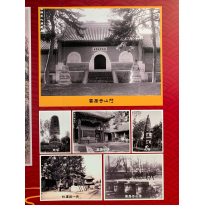Persistence through millennia, the stone scripture treasure shines in the world/
Beijing Fangshan Yunju Temple reappears in its grandeur.
At the juncture of spring and summer in Hong Kong, the weather is warm and pleasant. Every year at this time, art enthusiasts are filled with joy. With the famous Central Art Exhibition and the Basel Art Exhibition, followed by the Sotheby's, Christie's, and Poly Auction related exhibitions, the art scene is bustling, and the commercial atmosphere is thick, making it dazzling. In this tumultuous moment, the exhibition hall of the Li Zhaoji Creative Visual Arts Building at Hong Kong Baptist University is showcasing a key artifact exhibition of Beijing Fangshan Yunju Temple, undoubtedly a refreshing spring, with profound historical and cultural significance. Visitors can feel the solemn atmosphere of Buddhist culture in a tranquil environment!
Beijing Fangshan Yunju Temple, also known as "Beijing Dunhuang", houses more than 14,200 stone-carved scriptures, which are well known! The author has some understanding and deep feelings about Buddhist scriptures. Today, let me briefly introduce the history of Yunju Temple and its cultural value through the introduction of cultural relics!
Yunju Temple was founded at the end of the Sui Dynasty and the beginning of the Tang Dynasty. Venerable Master Jingwan (?-639 AD, the 13th year of the Tang Dynasty's Zhenguan) vowed to carve scriptures, thus establishing the temple. It is located on the Stone Sutra Mountain 70 kilometers southwest of Beijing, divided into the Upper Temple and the Lower Temple. It was extensively rebuilt during the Liao Dynasty, forming five courtyards, making it a famous Buddhist temple in the north! The temple is surrounded by mountains and faces water, with famous north and south pagodas. During the Kangxi period, it was again extensively repaired, with the construction of the Great Compassion Hall. Emperors Yongzheng, Qianlong, Jiaqing, and Daoguang of the Qing Dynasty visited Yunju Temple multiple times, and imperial palaces were expanded inside. Yunju Temple was destroyed by Japanese artillery fire in 1942, leaving only the mountain gate and the northern pagoda. After the founding of the People's Republic of China, it gradually received attention and protection, and its original appearance was restored. In 1987, Yunju Temple was opened to the public as a historical topic museum. In 1999, Yunju Temple officially resumed its status as a religious activity site!
Why did Venerable Master Jingwan spend so much effort to carve scriptures on stone tablets? The main reason was the political climate change. Emperor Taiwu of the Northern Wei Dynasty and Emperor Wudi of the Northern Zhou Dynasty destroyed Buddhism twice. The master feared the arrival of the Dharma-ending age, and for hundreds of years, handwritten Buddhist scriptures were destroyed and lost. Therefore, he vowed to carve Buddhist scriptures on stone tablets and placed them in the Leiyin Cave of the Stone Sutra Mountain for permanent preservation. Since then, monks have passed down the scriptures from generation to generation, and after the Tang, Song, Yuan, Ming, and Qing dynasties, they carved 1,122 sections and 3,572 volumes of Buddhist scriptures. It became the world's largest stone-carved library, creating a great miracle in the history of Chinese civilization.
The Fangshan Stone Stele is a representative work of Chinese character stone carving art, with regular script as its font. Regular script is a type of Chinese calligraphy that has been popular throughout China's history. The regular script font on the Fangshan Stone Stele is clear and standardized, with smooth lines, demonstrating the superb stone carving skills and calligraphy attainments of ancient craftsmen.
The volume of the Fangshan Stone Stele is not large, about two feet by three feet or three feet by four feet, with a thickness of about two and a half inches. The stone is as hard as iron, making it an ideal material for carving. Due to its moisture resistance, it can withstand thousands of years without being destroyed, making it an eternal art of Chinese religious history and culture!
The important collections of Fangshan Yunju Temple also include the "Southern Collection" and the "Northern Collection". The Southern Collection was named after being printed in Nanjing during the Yongle period of the Ming Dynasty and is an important official Buddhist scripture! The Northern Collection was named after being printed in Beijing after the capital was moved by Emperor Yongle of the Ming Dynasty. There are a total of 6,776 volumes of scriptures. The Northern Collection was written using Buddhist scriptures collected from the Yuan Dynasty imperial palace, with very high-quality paper and binding, making it a fine product in the history of Buddhist scriptures!
Another key cultural relic, the "Tongue Blood Avatamsaka Sutra", was written by Master Zuhui of Miaolian Temple in Chengdu in the 13th year of the Chongzhen period of the Ming Dynasty. Every morning, he pricked his tongue with blood and used it as ink to write the "Great Avatamsaka Sutra", with a total of 80 volumes and 600,000 characters. Although this important classic is not included in this exhibition, we are still deeply impressed after learning this fact from the pictures and texts.
The last cultural relic is the "Chinese-Tibetan Combined Scriptures", which was introduced into Tibet by Buddhism more than 1300 years ago. Sang Zan Ganbu, who worshipped Buddhism, sent people to India to study Sanskrit. After learning it, they translated Buddhist scriptures in Tibet. The scriptures written in Tibetan use horizontal layout, which pioneered the horizontal layout of Chinese characters, and has an important position in the history of Chinese printing!
In addition, this exhibition also arranges a very meaningful activity, which allows visitors to create freely. They can imprint the scriptures from the "wooden scriptures" onto paper with ink, which is a precious real experience. The finished products can be taken home as rare gifts, which can receive the blessings of Buddhism and have immeasurable merits!
The stone scriptures of Yunju Temple in Beijing are treasures of Chinese culture, created by ingenious craftsmanship, and are miracles of Chinese stone carving culture. The opportunity to appreciate them face to face is rare. Interested friends, please come to visit as soon as possible, because it will end in less than a week. This first exhibition abroad, in Hong Kong, is like a pavilion near the water, providing a rare opportunity to understand ancient religious beliefs and cultures!
Author
Mr. Robert T Li graduated from the Economics Department of the University of Hong Kong and has served as the Head of Liability Insurance in the Greater China region for an international insurance company. He has a passion for traditional Chinese culture and enjoys collecting art. He is actively involved in promoting awareness of traditional Chinese culture, music, and art among young people. He can be contacted at litaichai@gmail.com.
Uploaded on 2024.4.9




